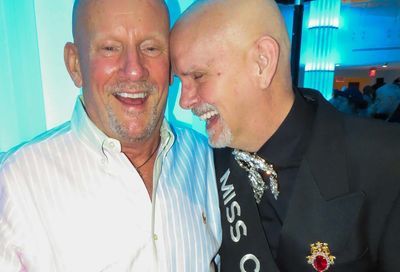Census Overlooks Many Same-Sex Couples
Despite gains in participation and identification, study shows one in seven gay couples won't be identified as partnered
One in seven same-sex couples won’t be identified as such in 2010 U.S. Census results, according to a new study. And the options on the census form to indicate relationship status are problematic for same-sex couples because they don’t reflect the differing ways that states — and the couples themselves — view their relationships.

The Task Force’s Darlene Nipper
(Photo by Todd Franson/Metro Weekly)
Data from the 2010 census won’t begin to be released until Dec. 31 of this year and data on same-sex couples won’t be available until some time after that. But the Williams Institute at UCLA designed a study – conducted by Harris Interactive — to determine how same-sex couples completed their census surveys.
The study used an online survey to question more than 600 individuals in cohabiting same-sex relationships about how they filled out the census.
The study’s author, Williams Distinguished Scholar Gary J. Gates, said in an interview that the findings will help researchers, journalists and others gain insight into the census data on same-sex couples once it is released.
On the census form, same-sex couples could make themselves known only if the household member designated as ”Person 1” indicated that he or she lived with a ”Husband or wife” or ”Unmarried partner,” and that the second person was of the same gender.
The Williams study found, however, that the census will miss about 10 percent of same‐sex couples because the couples identified themselves as ”housemates or roommates” or ”other non‐relatives” instead of as spouses or unmarried partners. It will also miss about 5 percent of same-sex couples because neither member was ”Person 1” in the household.
While census counts of same-sex couples are still forthcoming, data from the 2000 census indicated that approximately 595,000 same-sex couples identified as spouses or unmarried partners.
Among those couples who did not identify as spouses or unmarried partners in the 2010 census, about one-quarter said they did not do so because of their concerns about confidentiality. One-third said they did not identify as spouses or unmarried partners because they preferred other terms, and one-third said they were offended by the options or by the lack of a question about sexual orientation or gender identity.
The results are ”still telling us there’s stigma out there,” Gates said. They also show ”how difficult it is for same-sex couples to fill out government surveys,” he added. ”Survey systems haven’t caught up with all the different ways in which relationships are recognized today.”
The 2010 results will, nevertheless, be an improvement over the 2000 census, where an estimated 16 to 19 percent of same-sex couples were missed because they did not indicate themselves as married or partnered, according to a study by the Institute for Gay and Lesbian Strategic Studies. Gates said that a combination of factors likely led to the improvement, including a decrease in stigma about being identified as a same-sex couple and LGBT-targeted education campaigns conducted by the Census Bureau and a coalition of LGBT organizations.
State-to-state differences in recognition for same-sex couples still caused confusion in 2010, Gates said. Almost all married people who lived in states that recognize those marriages chose ”husband or wife.” Among married same-sex couples in states that do not recognize their marriages, however, only six in 10 identified as ”husband or wife.”
For people in civil unions or registered domestic partnerships, about 84 percent identified themselves on the census form as ”unmarried partners” and 16 percent used ”husband or wife.” If their home state recognized their relationship, though, almost 25 percent called themselves spouses, versus 12 percent in states with no recognition.
Nearly one-third of same-sex couples were in legally recognized relationships, and more than four in 10 of them lived in states that do not recognize those relationships.
Almost all couples not in marriages, civil unions or registered domestic partnerships chose ”unmarried partners.”
The Williams study also showed that nine in 10 same-sex couples completed and returned their census surveys, surpassing the seven in 10 rate among the general population.
Gates said the Williams study results will be used by the Census Bureau as part of a project to reevaluate the relationship options on future census forms and on the forms used for the American Community Survey (ACS), a yearly survey of 3 million households conducted by the Census Bureau. The ACS data, said Gates, is more detailed and is used most often by social scientists. The census data is now used primarily for congressional redistricting.
Che Ruddell-Tabisola, LGBT national partnership manager at the U.S. Census Bureau, confirmed that the bureau has already conducted focus groups of same-sex couples around the country as part of this multi-year reassessment. He could not say whether the project would lead to any definite changes but noted that a similar earlier study led to ”a significant change” in how questions on race and ethnicity were asked in the census.
Queer the Census, a project of the National Gay and Lesbian Task Force and Credo Action, has also been driving an effort to have LGBT people (coupled and not) and their families counted in both the census and the ACS.
”It is vital the federal government collect comprehensive data based on sexual orientation and gender identity,” explained Darlene Nipper, deputy executive director of the National Gay and Lesbian Task Force. ”Such information is critical in better addressing the issues and disparities facing LGBT people.”
Changes to either the ACS or the decennial census must be approved by the Office of Management and Budget and Congress.
Participants in the Williams study came from a pre‐existing national panel of LGBT individuals who were part of Harris Poll Online and volunteer to answer a variety of surveys. Williams researchers weighted the data so the sample closely matched the demographics of same‐sex couples identified in the 2008 ACS.
© 2010 by Keen News Service. All rights reserved.
Support Metro Weekly’s Journalism
These are challenging times for news organizations. And yet it’s crucial we stay active and provide vital resources and information to both our local readers and the world. So won’t you please take a moment and consider supporting Metro Weekly with a membership? For as little as $5 a month, you can help ensure Metro Weekly magazine and MetroWeekly.com remain free, viable resources as we provide the best, most diverse, culturally-resonant LGBTQ coverage in both the D.C. region and around the world. Memberships come with exclusive perks and discounts, your own personal digital delivery of each week’s magazine (and an archive), access to our Member's Lounge when it launches this fall, and exclusive members-only items like Metro Weekly Membership Mugs and Tote Bags! Check out all our membership levels here and please join us today!



















